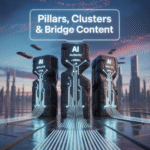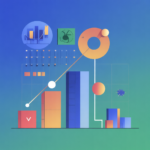How to Create an AI-First Business Roadmap
Most people try to wedge AI into whatever they’re already doing. They bolt it onto the side of a business model that barely worked before automation was an option.
They treat it like a new assistant instead of a reason to rethink everything. That’s the mistake.
If you want to build something that’s efficient, profitable, and built to scale, you don’t add AI last. You start with it.
An AI-first business roadmap doesn’t mean using robots to replace you.
It means looking at every layer of your business through the lens of what can be streamlined, accelerated, eliminated, or improved.
It means deciding what you shouldn’t do anymore because AI can do it better.
It forces you to confront the real bottlenecks and design a business that grows without becoming heavier.
Start with your time. Every business plan that ignores the time you actually have is a fantasy.
AI-first means mapping your energy first, then assigning the right tools to stretch that energy further.
If you only have two hours a day, you don’t waste it formatting blog posts or fiddling with Canva.
You use AI to build scaffolding so you can plug in your insight and ship.
Let’s say you’re building a business around digital products.
The old path might look like this: spend weeks outlining a course, spend more weeks scripting it, record it, edit it, create the sales page, launch it, and then build your funnel.
But if you go AI-first, you collapse those timelines. You use AI to analyze your audience and pull out the five most common pain points.
Then you run prompts to build draft outlines.
You refine the strongest one and ask AI to suggest formats that fit the transformation you’re delivering. You record or write only what’s necessary.
You ask it to build a launch calendar, prewrite the email series, and repurpose the copy for multiple platforms. That’s a roadmap that moves.
But it has to start from strategy. You can’t prompt AI effectively if you don’t know what you’re trying to accomplish. The roadmap begins with clarity.
What is your offer? Who is it for? What’s the result they want, and what friction is stopping them? Everything AI generates needs to move that forward.
If it doesn’t, it’s just busywork.
Next, look at your funnel. Most funnels are a mess of half-finished experiments. A freebie that doesn’t match the product. Emails that drift off after three days.
A checkout page no one tweaks.
In an AI-first business, every funnel asset gets built with the help of prompts that focus on friction. What objection would stop someone from opting in?
What promise needs to be reinforced at the upsell? What email needs to trigger based on behavior, not guesswork?
You don’t write copy by hand until you’re sure of the angle. You don’t build from scratch when a version of it exists in your own history.
Ask AI to pull themes from your highest-performing emails. Prompt it to improve abandoned cart flows based on real feedback.
This isn’t about getting AI to take over—it’s about getting it to give you a smarter starting point.
Now look at your content plan. The biggest time suck in any solo business is content creation.
You might spend hours each week trying to decide what to post, how to say it, or whether it even matters.
But your roadmap gets tighter when you use AI to reverse-engineer what your audience already responds to.
You input past blog posts, emails, or video transcripts and ask AI what got the most engagement.
What themes keep surfacing? What questions are being asked?
You turn that into a modular content system where each topic branches into micro angles, repurposed formats, and scheduled automation.
Instead of guessing what to post, you have a system that loops back into itself. You use AI to summarize long-form content into social snippets.
You turn a listicle into short-form video scripts. You ask it to rewrite a promo in a softer tone, then again in a punchier tone.
Now you’re not stuck trying to be creative every day. You’re optimizing and deploying.
AI-first also means shifting your mindset around team and scale. Most solo entrepreneurs think scaling means hiring. But hiring creates friction too.
Training, managing, reviewing, paying.
If your first move is to bring on a VA to handle admin, stop. First, prompt AI to handle those repetitive tasks.
Inbox sorting, research summaries, appointment scheduling, report generation. You don’t need a team when you have workflows.
Create SOPs with AI as the builder.
Prompt:
“Write a step-by-step workflow for repurposing a weekly newsletter into blog posts, tweets, and short-form video outlines.”
Then ask: “Where can AI handle or assist with these steps?” This shows you how to scale without the drag of headcount.
You also want to layer in AI at the product creation level. Most people wait until something is launched to start marketing it. But an AI-first roadmap flips that.
You market before you build.
Prompt AI to generate teaser content for a product idea. Share it. See who bites. Ask AI to summarize reactions or engagement data.
Use that to tweak the idea or pricing. Then build what people already showed interest in. No more launching into silence.
Let’s say you’re unsure what your next upsell should be. Instead of brainstorming blindly, prompt:
“Based on this product’s promise and customer objections, suggest five fast-win bonus offers that would increase conversions.”
Then ask:
“What format would reduce time-to-value for this bonus idea?”
Suddenly you’re building smart, layered offers with less work and more clarity.
But don’t skip measurement. An AI-first roadmap still needs checkpoints. Use AI to audit your email sequences.
Prompt:
“Here are my last 10 sales emails. Analyze which ones likely underperformed and why.”
Use it to track content relevance.
“Here are my last 5 blog posts. Tell me which one is most aligned with my buyer’s top problem, and suggest how to improve the others.”
Now zoom out and build your quarterly plan around these layers. Strategy first. Offer second. Funnel third. Content fourth. Tech and automation last.
Every phase gets AI input. But you guide the prompts. You bring the judgment. You decide where to double down.
A real-world example of this in action might look like this: You’re in the pet care niche and want to launch a digital product for dog owners struggling with barking.
You start by prompting AI:
“Analyze these customer reviews and YouTube comments to identify the biggest frustrations and desired outcomes for people dealing with barking dogs.”
It pulls patterns like nighttime noise complaints, embarrassment at the dog park, or tension with neighbors. You use that to build a product outline.
Then you prompt:
“Create a 4-week content plan around the emotional and practical sides of dog behavior problems.”
That becomes your lead generation system. You ask AI to write quiz opt-in copy: “What Kind of Barker Is Your Dog?”
The quiz flows into a product page you build from AI-assisted sales copy drafts. You track email open rates and ask AI to improve the subject lines.
Every step was built to move, not stall.
This roadmap only works when you’re active in it. The danger isn’t using AI. It’s thinking you can step away because the systems are smart now.
You still need to check the numbers. You still need to talk to buyers. You still need to test variations. But what you don’t need is to get buried in grunt work again.
That’s the point.
An AI-first roadmap gives you leverage. Not shortcuts. It gives you structure. Not scripts. You still have to think, decide, and adapt.
But now you do it with clearer insight and a smaller workload.
You can keep building the slow way—guessing, grinding, second-guessing—or you can start asking better questions, feeding better prompts, and getting to traction faster.
That’s the path. Map your business with AI at the center, not the edge. Use it to build momentum, not just to patch holes.
The faster you stop treating AI like a side tool and start designing around it, the faster you build something that doesn’t burn you out. The future isn’t AI versus you.
It’s AI behind you, clearing the road so you can actually drive.











0 Comments